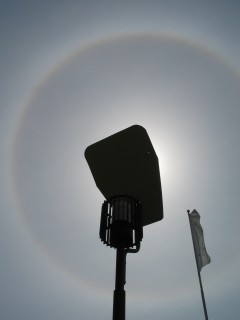Halo facts for kids
A halo is a special ring of light that appears around an object. You might have seen halos in old paintings, often around the heads of saintly people like Jesus. In these artworks, the halo shows that the person is holy or special.
Some people who follow Hinduism believe that the halos seen around holy figures in art show an "activated" crown chakra. This is a spiritual energy point in the body.
Halos are also amazing things you can sometimes see in nature. They appear as rings of light around the Sun or Moon. You might even spot them around bright street lights! These natural halos are called optical halos.
Contents
What Causes Natural Halos?
Most natural halos happen because of tiny ice crystals floating in the air. These crystals are usually found in high, thin clouds, like cirrus clouds. When sunlight or moonlight shines through these ice crystals, the light bends and reflects. This creates the beautiful ring shapes we call halos.
The way the light bends depends on the shape of the ice crystals. Different crystal shapes can create different types of halos. Sometimes, the light even splits into different colors, just like a rainbow. This happens because white light is made up of all the colors of the rainbow, and the ice crystals can separate them.
Types of Halos
There are many different kinds of optical halos, each formed by specific conditions of light and ice crystals.
22-Degree Halo
The most common type of halo is the 22-degree halo. It looks like a large, bright ring around the Sun or Moon. This halo is called "22-degree" because the light bends at an angle of 22 degrees as it passes through the ice crystals. These halos are often seen and are a sign that there are ice crystals high in the atmosphere.
Sun Dogs
Sometimes, you might see bright spots of light on either side of the Sun. These are called "sun dogs" or parhelia. They are also a type of halo, formed by ice crystals. Sun dogs often appear with the 22-degree halo and can be quite colorful, like small rainbows.
Circumzenithal Arc
Another beautiful halo is the circumzenithal arc. This looks like an upside-down rainbow high in the sky, usually above the Sun. It's often very bright and colorful. It forms when sunlight hits flat, hexagonal ice crystals in a specific way.
Moon Halos
Halos can also form around the Moon. These are often less colorful than sun halos because moonlight is not as bright as sunlight. However, they are still a beautiful sight and are formed by the same process of light interacting with ice crystals.
How to Spot a Halo
To see a natural halo, look up at the sky when the Sun or Moon is visible, especially when there are thin, high clouds. Remember to never look directly at the Sun without proper eye protection! You can often see halos by blocking the Sun with your hand or a building. Halos are a wonderful reminder of the amazing things that happen in our atmosphere.
See also
 In Spanish: Halo para niños
In Spanish: Halo para niños


